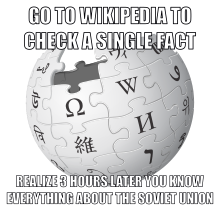
A text editor is a type of computer program that edits plain text. Such programs are sometimes known as "notepad" software. Text editors are provided with operating systems and software development packages, and can be used to change files such as configuration files, documentation files and programming language source code.

An Internet meme, or simply meme, is a cultural item that is spread via the Internet, often through social media platforms. Internet memes can take various forms, such as images, videos, GIFs, and various other viral sensations. Characteristics of memes include their susceptibility to parody, their use of intertextuality, their propagation in a viral pattern, and their evolution over time. The name is from the concept of memes proposed by Richard Dawkins in 1972.
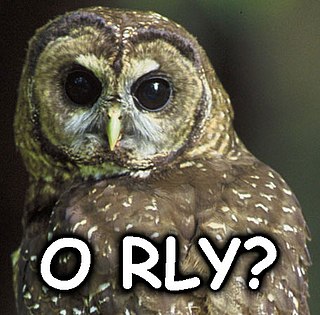
O RLY? is an Internet phenomenon, typically presented as an image macro featuring a snowy owl. The phrase "O RLY?", an abbreviated form of "Oh, really?", is popularly used in Internet forums in a sarcastic manner, often in response to an obvious, predictable, or blatantly false statement. Similar owl image macros followed the original to present different views, including images with the phrases "YA RLY", "NO WAI!!", and NO RLY.

A lolcat, or LOLcat, is an image macro of one or more cats. Lolcat images' idiosyncratic and intentionally grammatically incorrect text is known as lolspeak.

I Can Has Cheezburger? is a blog-format website featuring videos and image macros. It was created in 2007 by Eric Nakagawa (Cheezburger), from Hawaii, and his friend Kari Unebasami (Tofuburger). The website was one of the most popular Internet sites of its kind receiving as many as 1,500,000 hits per day at its peak in May 2007. ICHC was instrumental in bringing animal-based image macros and lolspeak into mainstream usage and making Internet memes profitable.
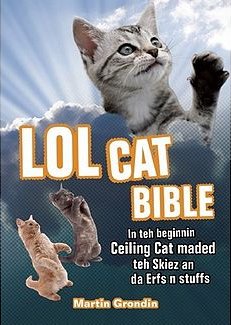
The LOLCat Bible Translation Project was a wiki-based website set up in July 2007 by Martin Grondin, where editors aim to parody the entire Bible in "LOLspeak", the slang popularized by the LOLcat Internet phenomenon. The project relies on contributors to adapt passages. As of March 27, 2008, approximately 61% of the text had been adapted, and Grondin stated that he hoped the entire New Testament would be complete by the end of 2008.
Cacography is bad spelling or bad handwriting. The term in the sense of "poor spelling, accentuation, and punctuation" is a semantic antonym to orthography, and in the sense of "poor handwriting" it is an etymological antonym to the word calligraphy: cacography is from Greek κακός and γραφή.

Trollface or Troll Face is a rage comic meme image of a character wearing a mischievous smile, used to symbolise internet trolls and trolling. It is one of the oldest and most widely known rage comic faces.
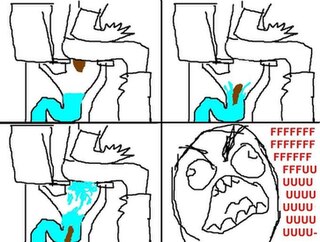
A rage comic is a short cartoon strip using a growing set of pre-made cartoon faces, or rage faces, which usually express rage or some other simple emotion or activity. They are usually crudely drawn in Microsoft Paint or other simple drawing programs, and were most popular in the early 2010s. These webcomics have spread much in the same way that Internet memes do, and several memes have originated in this medium. They have been characterized by Ars Technica as an "accepted and standardized form of online communication." The popularity of rage comics has been attributed to their use as vehicles for humorizing shared experiences. The range of expression and standardized, easily identifiable faces has allowed uses such as teaching English as a foreign language.

Overly Attached Girlfriend (OAG) is a fictional character and an Internet meme originating in a YouTube video published on June 6, 2012. The character was created by Laina Morris. The video was a submission to a contest held by Justin Bieber who challenged fans to create a "Girlfriend" counterpart to his hit song "Boyfriend". The video, which satirized elements of the Bieber song that have been perceived as clingy, featured Morris staring at the camera with a fixed smile while singing about Facebook-stalking her boyfriend and other themes.

Doge is an Internet meme that became popular in 2013. The meme consists of a picture of a Shiba Inu dog, accompanied by multicolored text in Comic Sans font in the foreground. The text, representing a kind of internal monologue, is deliberately written in a form of broken English. The meme most frequently uses an image of a Shiba Inu named Kabosu, though versions with other Shiba Inus are also popular.

Countryballs, also known as Polandball, is a geopolitical satirical art style, genre, and internet meme, predominantly used in online comics strips in which countries or political entities are personified as balls with eyes without pupils, decorated with their national flags. Comics feature the characters in various scenarios, generally poking fun at national stereotypes, international relations, and historical events, with them moving about by walking or jumping. Other common features in Countryball strips include non-English countries speaking in broken English—with vocabularies of their national languages included—political incorrectness, and black comedy. Strips are generally created using Microsoft Paint or more advanced tools, often made to intentionally look crudely drawn.

Kyle Edward Craven, commonly known by his Internet nickname "Bad Luck Brian", is an American Internet celebrity known for his ubiquitous photo posted on Reddit in 2012, which quickly became a popular Internet meme. Bad Luck Brian is an image macro style of meme. His captions describe a variety of unlucky, embarrassing and tragic events.
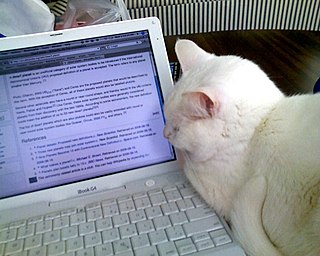
Images and videos of domestic cats make up some of the most viewed content on the World Wide Web. ThoughtCatalog has described cats as the "unofficial mascot of the Internet".
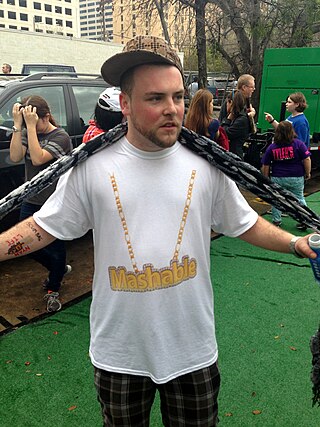
Blake Boston, commonly known as Scumbag Steve, is the subject of an Internet meme that became popular in 2011. It originated with a 2006 picture taken by Boston's mother, Susan, of then-16-year-old Blake Boston of Millis, Massachusetts, wearing a backwards fitted cap and winter coat with a fake fur collar. The meme generally superimposes text on top of the image of Boston consisting of an introductory sentence at the top and a punchline at the bottom. In 2012, Boston released a rap single on iTunes, under the alias "Blake Boston AKA Scumbag Steve" in an attempt to launch a career in music.
The history of humor on the Internet begins together with the Internet itself. Initially, the internet and its precursors, LANs and WANs, were used merely as another medium to disseminate jokes and other kinds of humor, in addition to the traditional ones. In lockstep with the progress of electronic communication technologies, jokers took advantage of the ARPANET, e-mail, Usenet newsgroups, bulletin board systems, etc, and finally the Whole World Wide Web. Gradually, new forms of humor evolved, based on the new possibilities delivered by electronic means of communication. A popular form of internet humour is found in the form of 'internet memes'. Reaction videos, where amusement is expressed through a person's response to something, are another prevalent form of humor unique to the internet.
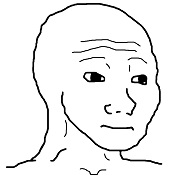
Wojak, also known as Feels Guy, is an Internet meme that is, in its original form, a simple, black-outlined cartoon drawing of a bald man with a wistful expression. The origin of the Wojak illustration is unknown. It may have emerged in 2009 on a Polish imageboard named vichan, from where it was later reposted to the German imageboard krautchan in 2010 by a poster called "wojak". It was posted on December 16, 2009, on an image aggregation website.
A starter pack, also referred to as a starterpack or starter kit, is an internet meme meant to describe or illustrate a stereotypical person, place, culture, object, or opinion.
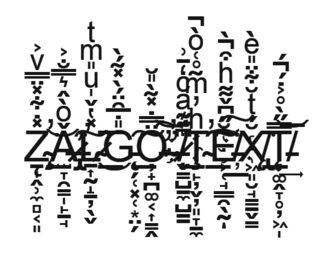
Zalgo text, also known as cursed text due to the nature of its use, is digital text that has been modified with numerous combining characters, Unicode symbols used to add diacritics above or below letters, to appear frightening or glitchy.
